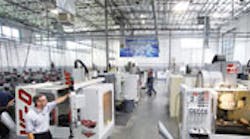Need a machinist? So do a lot of other companies. The problem is finding available, qualified machinists.
Even under the current economic downturn, the demand for engineers, machinists and machine operators remains high. Those three professions have made Manpower Inc.’s “Annual 10 Hardest Jobs to Fill” list in each of the past four years.
But, that concern is not as acute in the Los Angeles area as a result of a series of training centers operated by the National Tooling and Machining Assn. (NTMA). Since the facilities opened in 1968, over 15,000 machinists and operators have used the centers to learn their trade.
NTMA’s training centers are split into two campuses in Southern California, in Norwalk and Ontario. At Ontario, there are over 80 computers, with shops featuring 53 manual machines, two wire EDMs and 19 CNC machine tools.
The training centers partner with machine-tool manufacturer Haas Automation for its Haas Technical Education Centers (HTEC). The Ontario campus uses seven Haas vertical machining centers (VF-0, VF- 2SS, three Mini Mills and two TM-1 Toolroom Mills) and eight Haas CNC lathes (TL-1 Toolroom Lathe, SL-10, three SL-20s, three Mini Lathes). Additionally, there are six Haas CNC control simulators for classroom instruction.
The instructors, facilities and technology offer students the chance to learn advanced skills on highly sophisticated machinery.
“Some of the students have never been in a shop before, and this is all new to them,” said Jim Ragaisis, director of training for the NTMA Training Centers’ Ontario campus. “In module one, we teach students with no knowledge of machining that ‘this is a mill, this is a lathe.’ When they finish all five modules – which is 725 hours – they’re well prepared to start their careers.”
In addition to instruction in manual and CNC machining, programming, software design and inspection, NTMA Training Center classes also place a heavy emphasis on math and blueprint reading.
“Right from the start, we emphasize application mathematics,” says Ragaisis. “We tell students we’re going to use a lot of math and trigonometry. That scares them a little, but they can get past that. We bring it to life for them. We show them the academic math, bring it into a technical arena, then take them into the shop and demonstrate how to apply the math and make it work for them.”
Personal projects are encouraged. If a student would like to experiment beyond the confines of the curriculum, instructors usually will approve it, as long as a detailed blueprint is provided.
“The blueprint is extremely important,” says Ragaisis. “It’s the bridge from the idea to the project. We want to make sure they can produce a blueprint, read a blueprint and apply a blueprint, especially working with and understanding tolerances and dimensions.”
According to Lilly Ford, Ontario campus’ director, the training centers are fully accredited, so students may apply for financial aid, such as Pell Grants. Moreover, the 725-hour program qualifies as a year’s credit at El Camino Community College in nearby Torrance, Calif., and additional state programs are available for qualified shops that enroll workers to enhance their skills.
The training centers now have over 700 combined students, including an increasing number of female students.
“We specialize in machining,” says Ragaisis. “We have no other subjects. Our instructors have many years of experience in the industry. They all come from the field and teach practical, useful knowledge and application. Some instructors have their own shops or consult for industry, and some have European experience. We bring all that experience and knowledge to our students. That’s what we do best.”






